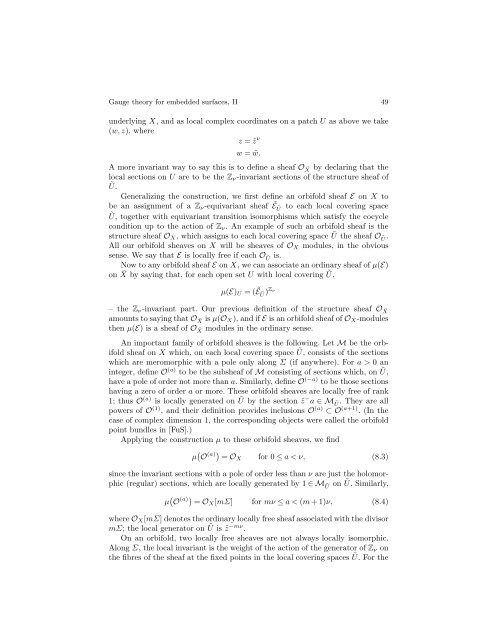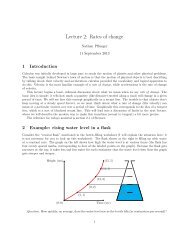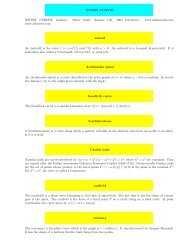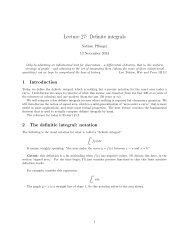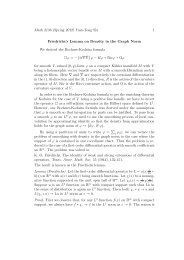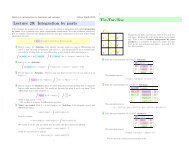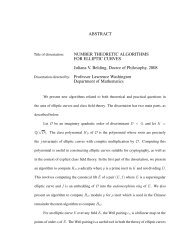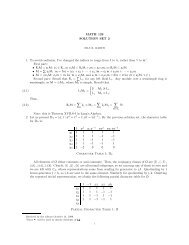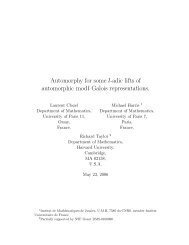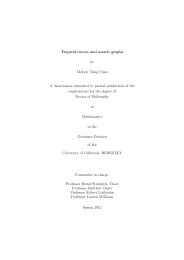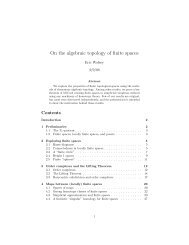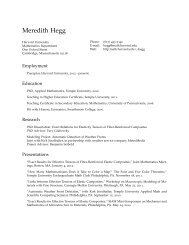Gauge theory for embedded surfaces, II
Gauge theory for embedded surfaces, II
Gauge theory for embedded surfaces, II
Create successful ePaper yourself
Turn your PDF publications into a flip-book with our unique Google optimized e-Paper software.
<strong>Gauge</strong> <strong>theory</strong> <strong>for</strong> <strong>embedded</strong> <strong>surfaces</strong>, <strong>II</strong> 49<br />
underlying X, and as local complex coordinates on a patch U as above we take<br />
(w, z), where<br />
z =˜z ν<br />
w=˜w.<br />
A more invariant way to say this is to define a sheaf O ¯ X by declaring that the<br />
local sections on U are to be the Zν-invariant sections of the structure sheaf of<br />
Ũ.<br />
Generalizing the construction, we first define an orbifold sheaf E on X to<br />
be an assignment of a Zν-equivariant sheaf ˜ EŨ to each local covering space<br />
Ũ, together with equivariant transition isomorphisms which satisfy the cocycle<br />
condition up to the action of Zν. An example of such an orbifold sheaf is the<br />
structure sheaf OX, which assigns to each local covering space Ũ the sheaf OŨ .<br />
All our orbifold sheaves on X will be sheaves of OX modules, in the obvious<br />
sense. We say that E is locally free if each OŨ is.<br />
Now to any orbifold sheaf E on X, we can associate an ordinary sheaf of µ(E)<br />
on ¯ X by saying that, <strong>for</strong> each open set U with local covering Ũ,<br />
µ(E)U =( ˜ E Ũ )Zν<br />
– the Zν-invariant part. Our previous definition of the structure sheaf O ¯ X<br />
amounts to saying that O ¯ X is µ(OX), and if E is an orbifold sheaf of OX-modules<br />
then µ(E) isasheafofO¯ X modules in the ordinary sense.<br />
An important family of orbifold sheaves is the following. Let M be the orbifold<br />
sheaf on X which, on each local covering space Ũ, consists of the sections<br />
which are meromorphic with a pole only along Σ (if anywhere). For a>0an<br />
integer, define O (a) to be the subsheaf of M consisting of sections which, on Ũ,<br />
have a pole of order not more than a. Similarly, define O (−a) to be those sections<br />
having a zero of order a or more. These orbifold sheaves are locally free of rank<br />
1; thus O (a) is locally generated on Ũ by the section ˜z− a ∈MŨ . They are all<br />
powers of O (1) , and their definition provides inclusions O (a) ⊂O (a+1) . (In the<br />
case of complex dimension 1, the corresponding objects were called the orbifold<br />
point bundles in [FuS].)<br />
Applying the construction µ to these orbifold sheaves, we find<br />
µ O (a) = OX <strong>for</strong> 0 ≤ a


